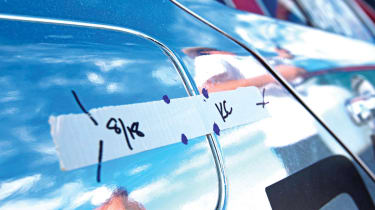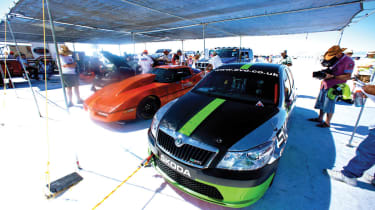227mph Skoda at Bonneville Speed Week - 227mph Skoda at Bonneville Speed Week - page 2
evo's Richard Meaden helped Skoda break an impressive record at Bonneville 2011. Here's the full story.
On the dyno at Salt Lake City, the Octavia managed 510bhp at the wheels in 100deg ambient temperatures and one mile above sea-level. That’s a lot to put through the front wheels of any car, let alone one running skinny tyres pumped to 60psi on a strangely slick surface. Everything’s fine until 5500rpm, at which point the turbo begins to wake up. A thousand rpm later it’s fully lit and so are the front wheels. It demands the shortest of short shifts through the first four gears, and even then it’ll break traction at will.
We get the rookie run and D licence run done in one hit, leaving me to complete my C, B and – hopefully – A licence runs. This means working up my average speeds in 25mph increments from 150 to 200 and beyond. Each run is a brilliant confidence- booster for me and provides invaluable data for the guys. It’s also proving effortless for the Octavia and bodes extremely well for our double-ton objective.
We make our first 200mph attempt on Monday afternoon. It’s clear the car has huge untapped potential, but it’s also apparent the standard ECU and ignition coil packs are close to the limit of what they can cope with. It’s Nick’s job to coax more from the hardware by being creative with the software, but doing it on the hoof is a huge challenge. Despite the growing pressure, Nick, Ricky and Andy are all adamant that the car will do the job: if it can pull 7000rpm in fifth, the gearing and rolling radius of the tyres will dictate a speed of 202mph. Nick has warned me I’ll need to be sensitive to the fuelling issues and possibly have to back off the throttle ever-so slightly at high rpm to try and help the injectors and coil packs catch up with the demands for more fuel and a stronger spark. Sure enough, it falters slightly but clears with some coaxing and pulls strongly to the rev limit Nick set.
As the Octavia rolls to a halt, dragging its flaccid ’chute behind, I’m not certain what our speed was, but when I hear the boys hollering from the big white Dodge Ram pick-up storming up the course to meet me, I know we’ve topped 200. A timing slip confirms the good news: 202.15mph. We’re all mildly stunned at the relative ease with which the Octavia has done it. The class record of 216mph is still a long way off, but with four days left and plenty to come from the motor, we know we have a good shot at doing something really special.
Even when you’re not driving (which is much of the time) Bonneville can still blow your mind, as I discover when I see a streamliner in full flight for the first time. A pencil-thin profile silhouetted against the gently curving horizon, these wheel-driven missiles skim through your peripheral vision like small black bullets across a dazzling sea of white and blue. Distance and physics dictate the scene and soundtrack stay bewilderingly out of sync, the low oscillating drone of a blown V8 hauling hard on a 400+mph gear totally at odds with the speed you’re witnessing. I swear there’s a collective pause as all eyes track the projectile’s progress, then as the ’chutes billow and the engine noise is snuffed like a candle we all breathe a sigh of relief, shake our heads in a mix of awe and admiration, then carry on with whatever we were doing. It’s a defining part of the Bonneville experience.
Things you take for granted when driving a standard car at high speed on a runway suddenly become magnified to an uncomfortable degree on the salt. Driving at 200mph on a solid surface in a car designed to do 200mph is no big deal, but contemplating 220 or more on slippery salt in a car with aerodynamics honed for 150mph is more than a little spooky. You hope it won’t swap ends, take off or find some other catastrophic way of ruining your day, but hoping is very different to knowing, which explains why there’s a different vibe within the team when the time comes to go for the G/PS class record.
We have to make two runs above the existing record of 216mph. The first run is in effect a qualification run that then entitles you to a record-setting attempt early the following day. It’s Thursday afternoon by the time our first chance comes. This means a further Tech Inspection to ensure the car is within the class rules. Fuel and water for the water-injection system is pumped out, then refilled with regulation fluids under the watchful gaze of SCTA officials. The tanks are then sealed and we’re waved towards the seven-mile-long Course 2. Having managed 214mph earlier in the day, we’re confident the Octavia has speed to spare, but there’s only one way to find out.
Nick has been constantly massaging the fuel mapping and we’re now beginning to get the car working well in sixth gear, but it’s not until I’ve soft-pedalled it through the first four gears, nailed it through fifth and dropped it into top at just over 200 that we know whether the latest tweaks have worked. There’s a momentary pause as the turbo winds itself up, but then the solid, relentless shove returns, powering the Octavia through the 220mph barrier before hitting Nick’s chosen rev-limit at just under 226mph!
The shutdown procedure is always the same. Pop the ’chute while hard on the power to maintain stability, feel the drag pull the car back and down into the salt, then ease off the throttle and coast down in gear to ensure the maximum oil and coolant circulation. Only when we come to a halt is the motor finally switched off. As you can imagine, the heat-soak is always extraordinary, but on opening the bonnet I know something’s wrong. The engine is literally humming with heat. Smoke is curling from the heat-wrap and I can hear the water boiling inside the head and block. It looks, sounds and smells bad.





